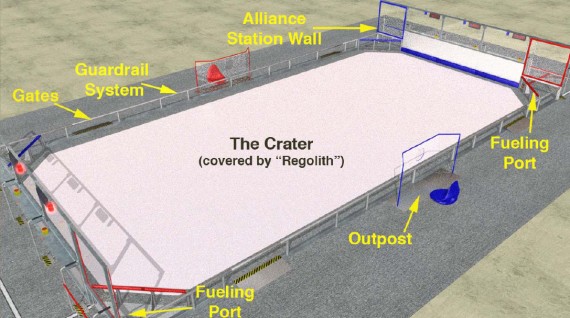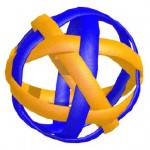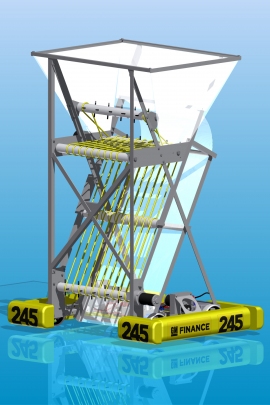2009: Lunacy
In Lunacy, six teams, two alliances of three, compete on the crater. The objective was to score the most points in opposing alliances’ trailers.
The game was divided into two periods: autonomous and teleoperated. The match, including both the autonomous and teleoperated periods, were 15 seconds and two minutes long respectively.

The game was played on a 24 by 50 foot field known as the crater. The crater was covered in a slippery material called regolith which made maneuvering around the field difficult.
Each robot pulled a trailer that the opposing alliance could place game pieces in to score.
Autonomous Period
During the autonomous period, the robot completely relied on programming to navigate and score. The autonomous period lasted 15 seconds.
Teleoperated Period
The teleoperated period was the two minute period in which drivers operated the robot.
Game Pieces
The game pieces were 9-inch diameter round objects made of braided 1-inch wide strips of fabric-covered polymer. They are commercially available as “Orbit Balls.” In the game, these pieces were known as “Moon Rocks”, “Fuel Cells” and “Super Cells” and were differentiated by color.
Scoring
- 2 Points for every Moon Rock placed in opponents trailer
- 2 Points for every Empty Cell placed in opponents trailer
- 15 Points for every Super Cell placed in opponents trailers
Super Cells could only be unlocked if a fueling station (corner area of the field) was in possession of an Empty Cell. These Super Cells could not be used until the last 20 seconds of a match.
More Information
Most of the information on this page was a simplified version of the FRC 2009 manual. For a more in-depth version, visit the FIRST website.
Our Solution: Olympia
-
Drivetrain
- Four wheels driven by two Andy Mark Tough Boxes with 8.45:1 gear ratio and one CIM each.
-
Roller System
- Two independent belts, both driven by CIMs with Andy Mark GEM500 gear boxes at 3.67:1.
- Rollers are made of PVC with air hoses going through the center for better ball handling.
- Amount of squish between roller and back: about 7-8 inches
-
Sensors
- Kit Encoders on both transmissions
- Yaw rate sensor
-
Features
- Easy to replace rollers
- Easy control system drop down
- Mostly Modular
-
Specifications
- Weight: 115 pounds
- Dimensions: 27.5 x 37.5 x 59.5





